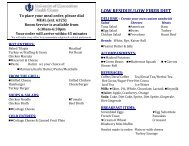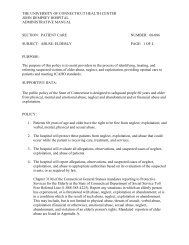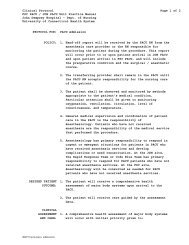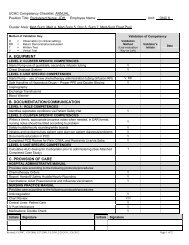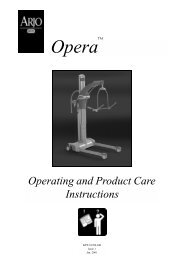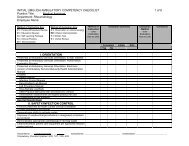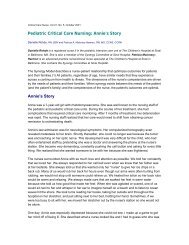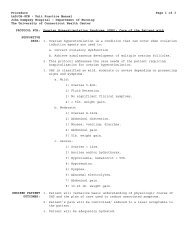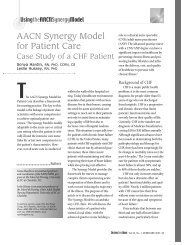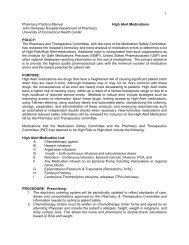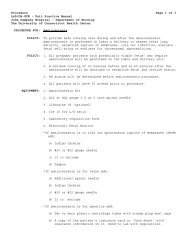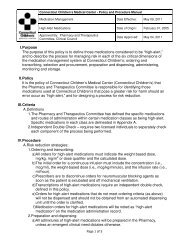Protocol Page 1 of 8 NICU/NBN - Department of Nursing - University ...
Protocol Page 1 of 8 NICU/NBN - Department of Nursing - University ...
Protocol Page 1 of 8 NICU/NBN - Department of Nursing - University ...
Create successful ePaper yourself
Turn your PDF publications into a flip-book with our unique Google optimized e-Paper software.
<strong>Protocol</strong> <strong>Page</strong> 1 <strong>of</strong> 8<strong>NICU</strong>/<strong>NBN</strong> – Unit Practice ManualJohn Dempsey Hospital – <strong>Department</strong> <strong>of</strong> <strong>Nursing</strong>The <strong>University</strong> <strong>of</strong> Connecticut Health CenterPROTOCOL FOR: Skin Care: NeonatalPolicy: 1. The Neonatal Skin Condition Score will be done on all patients inNewborn Nursery, Special Care Nursery and <strong>NICU</strong> once a shift.2. 3M No Sting Barrier Film requires MD/AP order. This product is onlyto be used for infants with a corrected gestational age <strong>of</strong> 36 weeksor greater.a. No Sting may be applied over severely excoriated or denuded skinbecause it is alcohol free.3. Commercial baby wipes are not permitted to be used on infantsbecause <strong>of</strong> additives that may be percutaneously absorbed and haveunknown effects.SUPPORTIVE DATA: There are functional differences between the term and preterm infant'sskin, which subside with increases in gestational age and postnatalage. Usually between 21-28 days after birth, the infant's skin, nomatter what gestation, matures.As part <strong>of</strong> the skin's protection, an acid mantle develops approximatelyfour days after birth. An acid surface (pH <strong>of</strong> 5, or have a breakdown score <strong>of</strong> 3,are at a higher risk for systemic infection.
<strong>Protocol</strong> <strong>Page</strong> 2 <strong>of</strong> 8<strong>NICU</strong>/<strong>NBN</strong> – Unit Practice ManualJohn Dempsey Hospital – <strong>Department</strong> <strong>of</strong> <strong>Nursing</strong>The <strong>University</strong> <strong>of</strong> Connecticut Health CenterPROTOCOL FOR: Skin Care: NeonatalDESIRED PATIENTOUTCOMES: 1. The infant’s skin will remain intact and free <strong>of</strong> infection.2. Transdermal absorption <strong>of</strong> topical agents will be minimized.3. The infant will experience no physical injury related to stripping<strong>of</strong> the epidermis, chemical burns, chemical infiltrates, pressurenecrosis or thermal burns.4. The infant will have minimal insensible water and heat loss.CLINCAL ASSESSMENTAND CARE: 1. Complete the Neonatal Skin Condition Score once a shift and documentscore on the flowsheet.2. Assess the infant’s total body surface including mucous membranes,with each hands-on care, considering:a. Skin exposed to topical chemical agents (betadine, benzoin).1) Report any areas <strong>of</strong> breakdown or change <strong>of</strong> status, includingmucous membranes (i.e. signs <strong>of</strong> thrush or any other reportablechange).b. Areas where skin touches skin (groin, underarms and behind theears).c. Weight bearing areas, bony prominences or areas where externaldevices are in contact with skin.3. Observe circumcision site, when appropriate, for evidence <strong>of</strong>erythema, edema, exudate with each diaper change.4. Assess IV insertion sites and evaluate circulation hourly inextremity distal to where IV is taped.a. Report any reddened, excessively swollen, blanching and/or anyarea <strong>of</strong> skin breakdown at IV site.5. Screen for potential sources <strong>of</strong> pain/discomfort that are related toskin breakdown.BATHING ANDCLEANSING: 1. Gloves should be worn for any hands-on caregiving prior to theinfant’s first bath. An infant whose mother has a history <strong>of</strong>/orsuspected hepatitis or HIV infection should be bathed as soon asthey are stable after birth.a. The infant should be wiped with a warm blanket in the deliveryroom immediately after birth to dry the infant and remove bloodand fluid from the delivery (unless a polyurethane wrap is usedfor thermal and fluid management <strong>of</strong> extremely low birth weightinfants).
<strong>Protocol</strong> <strong>Page</strong> 3 <strong>of</strong> 8<strong>NICU</strong>/<strong>NBN</strong> – Unit Practice ManualJohn Dempsey Hospital – <strong>Department</strong> <strong>of</strong> <strong>Nursing</strong>The <strong>University</strong> <strong>of</strong> Connecticut Health CenterPROTOCOL FOR: Skin Care: Neonatalb. An initial bath using mild low-alkaline or neutral pH soap willbe given once the infant’s temperature has stabilized and theinfant’s condition permits. For infants in the <strong>NICU</strong>, this bathwill be given in an isolette or on an open warmer.1) Temperature should be stable and within the normal range for 2to 4 hours before the first bath. The infant should bephysiologically stable because hypothermia related to bathingcan cause increased oxygen consumption and respiratorydistress.2) Do not remove vernix from the skin. Vernix may provideantibacterial protection and promote wound healing.c. Warm water baths will be given when needed during the first week<strong>of</strong> life for all infants in the <strong>NICU</strong>.1) Use sterile water for cleansing after diaper changes andbathing <strong>of</strong> infants < 26 weeks gestation. Avoid rubbing theskin surface.2) For the infant > 30 weeks gestation, low alkaline soap shouldbe used 2-3 times a week after the first week <strong>of</strong> life.3) For the infant < 30 weeks gestation, low alkaline soap shouldbe used 2 to 3 times per week after the second week <strong>of</strong> life.4) Rinse well to reduce irritation. The degree <strong>of</strong> irritation tothe skin from soap depends partially on the length <strong>of</strong> contactto the skin and the frequency used.d. Use developmentally appropriate swaddling methods for prematureinfants when bathing.e. Immersion bathing in tub may be beneficial, if clinicallypossible in full term or healthy preterm, because it removessloughed skin cells and re-hydrates the skin.f. Infants older than 2 months, regardless <strong>of</strong> gestational age, maybe bathed every other day or as needed using a low alkaline soapas long as clinical condition permits.g. Moisten mucous membranes with water soaked gauze or cotton tippedapplicator every 4 hours for infants who are NPO or receivinggavage nutrition.CORD CARE: 1. Wash hands before handling umbilical cord area. During the firstbath, clean the cord and surrounding skin with the mild, lowalkalinesoap that is used for bathing. Rinse thoroughly.a. Cleanse cord and surrounding skin with sterile water if first bathis delayed.b. Keep cord clean and dry. If the cord becomes soiled with urineor stool, cleanse with water.
<strong>Protocol</strong> <strong>Page</strong> 4 <strong>of</strong> 8<strong>NICU</strong>/<strong>NBN</strong> – Unit Practice ManualJohn Dempsey Hospital – <strong>Department</strong> <strong>of</strong> <strong>Nursing</strong>The <strong>University</strong> <strong>of</strong> Connecticut Health CenterPROTOCOL FOR: Skin Care: Neonatal1) Report any drainage, bleeding, odor or redness immediately toMD/AP.c. Remove cord clamp when cord is dry at about 24 hours after birth.d. Educate families about cord care, normal cord healing andimportance <strong>of</strong> hand washing before handling the umbilical cord.SPECIALCONSIDERATIONS FORINFANTS ONCPAP/SiPAP: 1. Assess nares, head, face and ears <strong>of</strong> infants on nasal CPAP/SiPAP.Refer to <strong>Protocol</strong> For: CPAP: Nasal and Infant Flow SiPAP andProcedure For: Cannulaide Application and Use.a. Examine the external area <strong>of</strong> the nose for redness or excoriationwith every hands-on care.1) Report any redness or other significant findings <strong>of</strong> the nasalarea to MD/AP.2) Presence <strong>of</strong> erosion, tissue loss, or bleeding requiresdocumentation.b. Remove the CPAP/SiPAP bonnet to examine the head face and earsfor redness, molding or indentation with each hands-on care.1) Report any redness or other significant finding to MD/AP.2) Check the outer ears to ensure that they are not folded overand that behind the ears are clean.2. Assess internal nares, using a laryngoscope or pen light, at leastevery 24 hours.a. Examination should be performed with the Medical Staff.3. Use a barrier for a protective layer between the skin and CPAP/SiPAPprongs.PREVENTION OF SKINBREAKDOWN: 1. Minimize transdermal absorption <strong>of</strong> topical agents and chemicalburns:a. Confine the use <strong>of</strong> betadine, alcohol or benzoin to smallest areaspossible.b. Remove betadine and other topical agents with warm water as soonas possible.c. Dilute betadine to half strength for infants less than 1000gmwhen prepping the skin for procedures.2. Prevent epidermal stripping:
<strong>Protocol</strong> <strong>Page</strong> 5 <strong>of</strong> 8<strong>NICU</strong>/<strong>NBN</strong> – Unit Practice ManualJohn Dempsey Hospital – <strong>Department</strong> <strong>of</strong> <strong>Nursing</strong>The <strong>University</strong> <strong>of</strong> Connecticut Health CenterPROTOCOL FOR: Skin Care: Neonatala. Confine adhesives to the smallest possible area <strong>of</strong> the skin.3) Use hydrogel adhesives when possible.4) S<strong>of</strong>t gauze wraps may be used to help secure equipment.b. Minimize tape used directly on the skin.1) Back tape with cotton or tape when possible.c. Avoid the use <strong>of</strong> Band-aids due to the strength <strong>of</strong> the adhesive.d. Use skin barrier (pectin or hydrocolloid) between skin and tapefor umbilical artery and umbilical vein catheters, endotrachealtube, nasal cannula or nasogastric tube.1) Wash skin with water (not alcohol) and dry before applying thebarrier.e. When removing adhesives, apply water soaked cotton balls or gauzeand gently remove.1) Delaying removal <strong>of</strong> tape at least 24 hours after applicationwill reduce epidermal stripping.2) Mineral oil or emollient such as Petrolatum or Aquaphor mayalso be applied to adhesives to ease removal.3. Prevent pressure necrosis:a. Avoid constrictive tape with arm boards or other devices.b. Change infant’s position every 2-4 hours as infant’s conditionpermits.c. Use a fluffy when prematurity or immobility necessitates.d. Position and secure IV tubing, central venous line clamps, andchest tubes so that they do not cause pressure areas on theinfant’s skin surface.e. Change the pulse oximeter per protocol.4. Prevent thermal burns:a. Avoid direct contact <strong>of</strong> a heat source with the infant’s skin.b. Use lowest TcPCO 2 temperature to achieve accurate readings.5. Prevent infection by:a. Meticulous hand washing.b. Avoiding using tape or transparent dressings over any infectedareas on the skin.
<strong>Protocol</strong> <strong>Page</strong> 6 <strong>of</strong> 8<strong>NICU</strong>/<strong>NBN</strong> – Unit Practice ManualJohn Dempsey Hospital – <strong>Department</strong> <strong>of</strong> <strong>Nursing</strong>The <strong>University</strong> <strong>of</strong> Connecticut Health CenterPROTOCOL FOR: Skin Care: Neonatalc. Keeping all sites <strong>of</strong> insertion for invasive lines clean withtransparent, occlusive dressings if applicable.TREATMENT OFDIAPER DERMATITIS: 1. Try to prevent diaper dermatitis by changing diapers frequently,cleaning the diaper area after every void and/or stool, drying theskin after cleansing and using diapers with absorbent gel materials.2. Do not use heat lamps to dry areas <strong>of</strong> skin breakdown. Dryhealing may desiccate tissue and reduce migration <strong>of</strong> epithelialcells during healing.3. Consider using petroleum-based lubricants or zinc oxideprophylactically in infants at high risk, for example, infantsexposed prenatally to opiods.4. When using emollients or barrier ointments:a. Apply in a thick layer so that with cleansing it is necessaryto remove only the top layer <strong>of</strong> ointment.b. Do not use vigorous friction to scrub all the emollient orbarrier <strong>of</strong>f between applications.c. Use less complex substances first, for example, petrolatum orzinc oxide and assess effectiveness before changing to anothersubstance. (Note: more complex substances contain moreinactive ingredients that are potentially absorbed and whoseeffect may be unknown.)d. Allow sufficient time to assess effect <strong>of</strong> one treatment beforechanging to a different skin care regimen plan. Avoidchanging treatments based on individual preferences; adhere tothe established plan.SPECIALCONSIDERATIONS FORTHE EXTREMELY LOWBIRTH WEIGHTINFANT (< 750 GM): 1. If the skin has a gel-like appearance, sterile cotton balls may beused instead <strong>of</strong> wash clothes or gauze.2. Raise the isolette humidity above 70% to prevent transepidermalwater loss.3. Apply the tiny leads and smaller probe covers to decrease amount <strong>of</strong>contact with skin surface. Use heart rate from umbilical arterycatheter, if appropriate.4. Position adhesives on transparent dressing or skin barrier whenpossible.5. Pulse oximeter sites may need to be changed as frequently as hourly.Time <strong>of</strong> application may be increased gradually. Application timeshould not exceed four hours. Place a small piece <strong>of</strong> transparentdressing on the pulse oximeter to reduce adherence to infant’s skin.
<strong>Protocol</strong> <strong>Page</strong> 7 <strong>of</strong> 8<strong>NICU</strong>/<strong>NBN</strong> – Unit Practice ManualJohn Dempsey Hospital – <strong>Department</strong> <strong>of</strong> <strong>Nursing</strong>The <strong>University</strong> <strong>of</strong> Connecticut Health CenterPROTOCOL FOR: Skin Care: Neonatal6. Consider using small pieces <strong>of</strong> transparent dressing over infant'sback, chest, and abdomen and/or in areas where skin touches skinafter initial bath has been given. Consult with physician or APprior to initiating this intervention. Transparent dressings shouldnot be placed in areas where invasive devices may need to be placed.7. Consider covering any denuded area that is free <strong>of</strong> infection withtransparent dressing or skin barrier (Duoderm). Consult withphysician or AP prior to initiating this intervention.8. If nystatin powder is used, gently rinse (do not rub) with sterilewater and allow skin to dry between applications. Nystatin powderis only used per MD/AP order. Use a cotton ball to apply powder.Do not shake powder onto infant. *Powder promotes dry woundhealing.9. When caring for infants with extensive skin breakdown or at risk forextensive skin breakdown consider use <strong>of</strong>:1) Sterile gloves for handling.2) Sterile linen and diapers (use to cover fluffy).a. Cleanse areas <strong>of</strong> skin breakdown with warm sterile water.b. Consider using:1) Telfa for diaper.2) Telfa patches where skin touches skin.10) Consult with physician or AP regarding pain management if this is aconcern.GUIDELINES FOR USEOF TOPICALOINTMENT THERAPY: A topical ointment (such as Aquaphor Original Formula) may be used forthe prevention <strong>of</strong> skin breakdown and reduction <strong>of</strong> insensible water lossin extremely premature infants.1. Cleanse skin with sterile water prior to application.2. Infants must have a temp > 98°F for greater than 2 hours prior toinitial application.3. Umbilical, Central and Peripheral IV lines should be in place priorto the initial application.4. When topical ointment is ordered, spread it in a thin layer to coverthe entire body except for face, scalp and areas where monitorleads, temp probes, and IV catheters are in place. Apply ointmentat the ordered frequency.5. Monitor temperature changes, fluid and electrolyte balance and skinintegrity – watch for breakdown and infection.
<strong>Protocol</strong> <strong>Page</strong> 8 <strong>of</strong> 8<strong>NICU</strong>/<strong>NBN</strong> – Unit Practice ManualJohn Dempsey Hospital – <strong>Department</strong> <strong>of</strong> <strong>Nursing</strong>The <strong>University</strong> <strong>of</strong> Connecticut Health CenterPROTOCOL FOR: Skin Care: Neonatal6. Wash ointment <strong>of</strong>f with mild soap if removal is required for leadchanges, IV starts, etc.GUIDELINES FOR USEOF NO STINGBARRIER FILM: 1. Clean skin <strong>of</strong> perianal area and dry before applying 3M No StingBarrier Film.2. Apply film generously over affected areas <strong>of</strong> skin. Hold skin foldsapart to permit film to dry thoroughly.3. Re-apply No Sting every 24 hours. For very frequent stooling, every12 hour application may be needed.4. Do not use other creams or ointments with No Sting.APPROVAL: <strong>Nursing</strong> Standards CommitteeEFFECTIVE DATE: 11/93REVISION DATES: 12/94, 3/97, 10/98, 2/00, 2/01, 12/02, 10/03, 12/08, 10/09, 4/10REVIEWED DATES: 12/07



